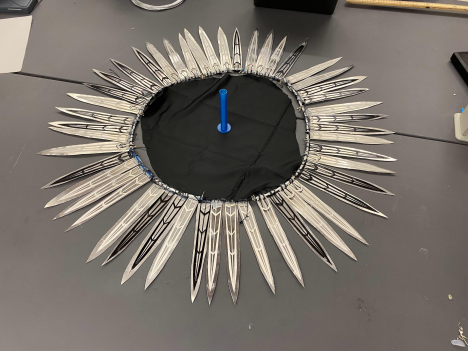MCLA Physics Students Design & Build Model for NASA StarShade Undergraduate Challenge
A group of MCLA students received a $1,000 honorarium from NASA in the fall 2023 semester to purchase equipment to design and build a model of a device that would be launched into space as part of the StarShade Undergraduate Challenge.
MCLA Physics Professor Dr. Kebra Ward fielded interest from students in the physics department to participate in the project, which led to a group with deeply diverse skill sets from physics, chemistry, math, computer science, and sociology. Last summer NASA put a call out to all undergraduate physics programs in the country for students to submit a 1:100 scale model of a device that could launch into space in order to block out the light of the star the exo-planet orbits so that the ground-based telescope can best observe the exo-planet.
In addition to the equipment award, the group applied for an MCLA mini-grant to fund the project.
MCLA Sophomore Téa Caravello led the team as her first independent research project last fall. The model was submitted on Dec. 15 and Caravello walked away with an educational experience including research, design, 3D modeling, and team management. She also presented research from the project at this past Undergraduate Research Conference.

“The NASA team had a lot of requirements in terms of what they wanted from this project,” she said. “It was clear that this was designed for a team much larger than ours. Because of this, we approached the project intending to create a new idea, learn the research and design process, and generally try our best! While the project was definitely a challenge, it was a lot of fun and I learned a ton from the experience that I will carry into future projects both at MCLA and beyond!”
MCLA’s design focused on optimizing petal deployment and stability once in space. The team’s goal was to innovate some aspects of previous starshade concepts with the goal of lower mass and a unique new concept. The students chose to innovate a new center frame that would be able to fold tall but compactly within the required dimensions of the container for launch.
According to the American Institute of Physics, Starshades can cast deep shadows of the target star if they are properly shaped to manage diffraction. The optimal shape has a central dark region surrounded by tapered petals. Originally it was thought that only telescope/starshade combinations in outer space could achieve adequate performance. But with the 30 m class telescopes (GMT, TMT, and ELT) currently under construction on Earth and high-performance single conjugate adaptive optics (SCAO) at visible wavelengths, it will be feasible to make these observations from the ground.
